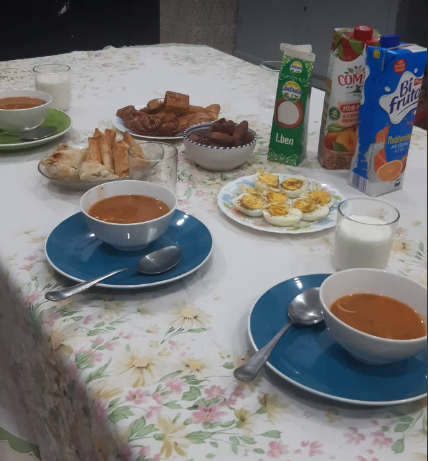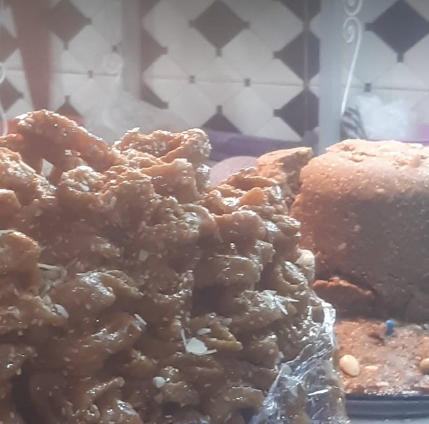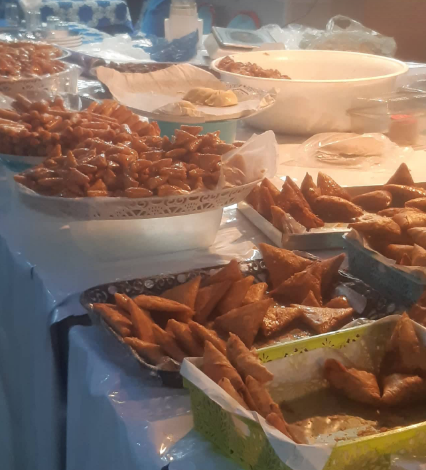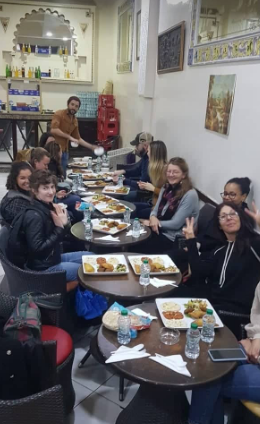Ramadan Breakfast
Ramadan Begins
“Join us for breakfast – Ramadan breakfast on Monday.”
Excellent! That will be a nice start to the day, I think. “What time?”
“6:30pm.”
Huh?!!!
This so confused me my first Ramadan – these constant invitations to breakfast at the ‘wrong’ end of the day.
Well actually, my second one too. But I’ve got it straight in my head now.
Ftour or Iftar means the same as breakfast – literally, breaking the fast. But while normally that would be breaking the overnight fast after sleeping, in Ramadan it means at sundown, at the end of the day of fasting.
So for those of you who may not know, what exactly is Ramadan and how does it work?
The idea is a month of peace and goodwill, appreciating those who go without by going without for the hours of daylight. Nothing to eat. Nothing to drink, not even water.
It is fixed by the new moon – much like Easter. But while easter is fixed within a certain space of time, somewhere between February and April, Ramadan constantly moves forwards. Last year it was in May, this year April, next it will be March, and so on.
In Morocco anyway, they get up at 3am for supper, then no food or water, til sundown. No smoking. No alcohol. No sex. I guess a version of lent. All are haram, or forbidden.
Juice or lben (fermented milk), eggs, harira soup, pastries, shabakia, and dates - breaking the fast.
The fast is then broken with orange juice or fermented milk, hard boiled eggs cut in half and sprinkled with cumin, and dates.
Three dates.
Why three?
I’m not entirely clear, but it seems that it’s mostly just because, like many countries, odd numbers are considered nicer. I guess 1 date isn’t enough, and five is just too many. So three it is, a nice amount that works for the symbolism.
Maqlouba - upside down dish, rice (and tongue) dish lined with eggplant, capsicum, tomatoes, potatoes, cauliflower, onions, tipped upside down and still steaming, ready to eat with the chicken pieces.
The first night last year my friend from Jordan cooked his Ramadan dish, maqlouba – a rice one cooked in layers in a pot, starting with slices of eggplant/aubergine, slices of other vegetables (like tomatoes, potatoes, capsicums/peppers, onions, cauliflower), and mixed through with cow’s tongue, all cooked in one pot without stirring – like a pie. It is then carefully inverted onto a plate, the eggplant from the bottom now making the “pie” top. It is eaten with a sprinkling of roasted almonds (or the poor man’s version, peanuts – which is what I’ve got used to and love).
All eaten with bread and fingers. (no, not like fish fingers that you eat - I mean by using your fingers to eat with. Kid-heaven, lol)
Shbakia, the pastries doused in honey, and on the right, sfouf (don’t you just love that word!)
Other special Ramadan foods include shbakia, a pastry, deep fried and wriggly, doused in honey and topped with sesame seeds.
Sfouf, a very solid ‘crumble’ of finely ground nuts made into a cake and eaten with a spoon.
Every table I’ve been to in a home always seems to have an array of salty foods (pastries and butbut) and sweets – the Moroccan ones are anything you can do with nuts.
Some pastries filled with meat, everywhere through Ramadan
The big thing is waiting til sundown.
The first breakfast of Ramadan my flatmate said hey, let’s go get something to eat.
Yup. All ready.
And he’s out the door. I run to follow.
His pace is usually a fairly slow one. He does a lot of work on his phone so as he walks he often slows to answer messages etc.
But not this time. He was on the move. I was a little surprised.
The streets for the past hour or two have had a jarred and frantic energy, and been completely chaotic as people rush to get their supplies and get home. All day the roads have been solid with rush-hour type traffic. I can only guess that since the national pastime of sitting in one of the hundreds of coffee shops is not an option in the daytime, plus shortened work hours, everyone is bored and so they roam the streets in their cars.
This is not an angled photo - it is even more crowded than the photo could show, jam packed with people and cars. The energy is frenetic - not just this crazy rush to grab the last minute things and get home, but a crazy rush fueled by 16 hours with no food or water.
But now the streets are quiet – no cars, no people. I am walking through a ghost town. We make our way to a small café-restaurant.
I kid you not - the street goes from the above to this in about 15 minutes. It is now 7pm.
Every table is set out with a glass of sour milk or juice, and a plate with a boiled egg cut in half.
And three dates.
No one touches their food. They sit in pairs on one side of each table, facing the windows.
A countdown. Sunset in Tangier on day one was at 6:53pm, and not a moment before.
Then we hear the prayer call
The juice disappears.
The dates and eggs disappear.
And the soup comes.
Also an integral part of every Ramadan breakfast.
Harira.
Tomato based and filled with coriander and other herbs, plus some chick peas and short noodle-pasta. It is one of the best soups I have had.
Many businesses are just shoeboxes in a wall, including restaurants. They serve just one thing, with three stools. Maybe a soup with bread. Harira or bsara, a thick soup made from split peas.
I have my favourite harira shoebox shop – though to tell the truth it’s not the only excellent harira I have eaten. But it is a small shop with orange frontage in Rue d’Italie just down from the grand socco fountain.
5 dirhams for an excellent soup – 6 dirhams with bread. That’s 0.60 euro cents, or $0.60 USD.
And after the soup – a simple but excellent meal – grilled chicken kebabs and kofta.
I am so not a fan of mince meat. I have found it so boring – too many meals of what the English call savoury mince.
That’s minced meat. Fried up.
Nothing else.
And not a fan of hamburgers either.
In the end, I think, the west does not know how to do it well.
After years I have also managed to find a spaghetti bolognese that works for me, maybe because it’s so drowned in various sauces it’s not much of a bolognese – one the Italians would no doubt cringe over.
Oh – and an old favourite from the Bee House a restaurant I frequented in Ierapetra in Crete in 1985 – spaghetti pie. It doesn’t even matter the quality of Bolognese. A metal bowl filled with cooked spaghetti, topped with some Bolognese sauce, and loads of grated cheese which is cooked in the oven til it melts to a toasted brown melty crusted layer a quarter of an inch thick – all of which is then inverted onto a plate.
But that is it for the west. Mince is a meat that I avoid – and there is little that I am not willing to eat.
Then we get to Morocco. When it comes to meatballs, rissoles – or kofta – they know what they are doing, and I find myself more often going back for more of the mince kofta kebabs than the grilled chicken.
Mince and liver kebabs.
And so was our first Ramadan breakfast, on the Sunday.
Monday breakfast was a splendid array from my favourite restaurant – the Syrian (Abou Tayssir in Rue d’Italie). Falafels, dips of houmous, babaganoush and capsicum/red peppers, pastries, and soup of course, a lentil one this time.
The three dips starting from the left - humus, red capsicum/pepper, white babaganoush (eggplant dip with yoghurt). Then from the top corner, a small salad, some of the best falafels, and a special Levantine Ramadan sweet which has cheese inside a kind of pancake, baked then doused in honey.
We’ve had the Jordan rice dish, moulokheya – the Egyptian national dish with chicken in a soupy sauce based on a dried type of spinach with lashings of lemon juice, and tajine cooked by a friend.
Great food, great company every night, because Ramadan is about being with family and friends.









